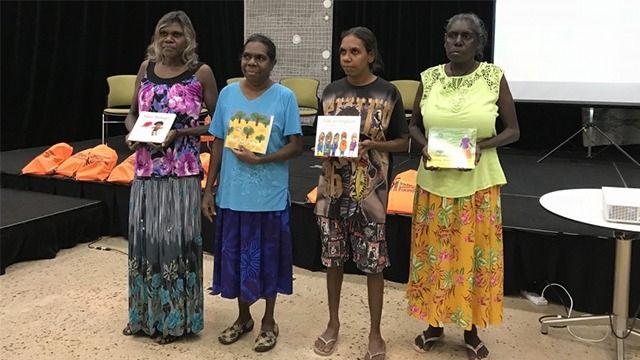Aboriginal language book developed by linguistics scholar set to make mark on Italy

Binjari women authors from L to R: Maureen Hodgson, Karen Manbulloo, Stella Raymond and Marilyn Frith. Image supplied.
An Aboriginal language children's book that an ANU linguistics PhD scholar helped develop will be showcased at a major book fair in Italy.
The book, Moli det Bigibigi (Molly the Pig), is one of nine children's fiction books in the Aboriginal language Kriol written and illustrated by Indigenous women from the remote Binjari community near Katherine in the Northern Territory. Moli det Bigibigi will be presented at the Bologna Children's Book Fair at the end of this month.
While researching the use of Kriol in Binjari for her PhD, ANU School of Literature, Languages and Linguistics scholar Denise Angelo helped the local women to write and illustrate the stories.
"Not only is it the first time community-written stories in Kriol have appeared in print, it's also the first time an Aboriginal Kriol book has appeared on the international stage," said Ms Angelo from the ANU School of Literature, Languages and Linguistics.
Moli det Bigibigi (Molly the Pig) was written by Karen Manbulloo and is based on a real-life pet pig in the community which loves eating Weet-Bix.
Ms Angelo said the stories have been a big hit with school children.
"When the Binjari women authors did some readings in the schools in Katherine, the Kriol-speaking children were instantly engaged, It was probably the first time they'd heard their vernacular used by an adult up the front of a classroom," said Ms Angelo.
The Indigenous Literacy Foundation funded the project to publish the nine Kriol children's books.
Ms Angelo said that some religious and school texts had appeared in Kriol in previous decades, but there hadn't been a history of publishing stories in Kriol to read to kids for everyday enjoyment.
"Kriol is the most widely spoken contemporary Aboriginal language, it's a living vibrant language, but it's an untapped resource that could be put to better use to support classroom learning," Ms Angelo said.
"Binjari people grow up speaking Kriol as their first language, while English might be their third or fourth language.
"All the books and all classroom lessons are in English, yet we don't actually teach the English language in most classrooms. The Binjari Kriol books are great because they can help to get the children engaging through the language they're good at."
Kriol developed into a full language from a pidjin language during the 20th century. The pidgin was used initially in New South Wales in the early days of colonisation.
"Over the past century, Kriol has emerged as the single most important form of communication for modern day communities across much of the cattle belt of the far north of Australia," Ms Angelo said.
"There's now demand for the Binjari books from other schools and communities and the Indigenous Literacy Foundation is distributing copies free of charge."